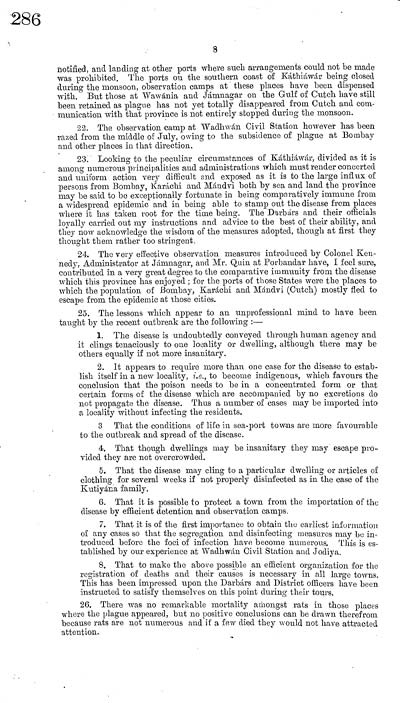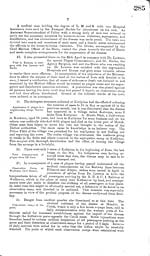Medicine - Disease > Account of plague administration in the Bombay Presidency from September 1896 till May 1897
(300) Page 286
Download files
Individual page:
Thumbnail gallery: Grid view | List view

8
notified, and landing at other ports where such arrangements could not be made
was prohibited. The ports on the southern coast of Kthiwr being closed
during the monsoon, observation camps at these places have been dispensed
with. But those at Wawnia and Jmnagar on the Gulf of Cutch have still
been retained as plague has not yet totally disappeared from Cutch and com-
munication with that province is not entirely stopped during the monsoon.
22. The observation camp at Wadhwn Civil Station however has been
razed from the middle of July, owing to the subsidence of plague at Bombay
and other places in that direction.
23. Looking to the peculiar circumstances of Kthiwr, divided as it is
among numerous principalities and administrations which must render concerted
and uniform action very difficult and exposed as it is to the large influx of
persons from Bombay, Karachi and Mndvi both by sea and land the province
may be said to be exceptionally fortunate in being comparatively immune from
a widespread epidemic and in being able to stamp out the disease from places
where it has taken root for the time being. The Darbrs and their officials
loyally carried out my instructions and advice to the best of their ability, and
they now acknowledge the wisdom of the measures adopted, though at first they
thought them rather too stringent.
24. The very effective observation measures introduced by Colonel Ken-
nedy, Administrator at Jmnagar, and Mr. Quin at Porbandar have, I feel sure,
contributed in a very great degree to the comparative immunity from the disease
which this province has enjoyed; for the ports of those States were the places to
which the population of Bombay, Karchi and Mndvi (Cutch) mostly fled to
escape from the epidemic at those cities.
25. The lessons which appear to an unprofessional mind to have been
taught by the recent outbreak are the following :-
1. The disease is undoubtedly conveyed through human agency and
it clings tenaciously to one locality or dwelling, although there may be
others equally if not more insanitary.
2. It appears to require more than one case for the disease to estab-
lish itself in a new locality, i.e., to become indigenous, which favours the
conclusion that the poison needs to be in a concentrated form or that
certain forms of the disease which are accompanied by no excretions do
not propagate the disease. Thus a number of cases may be imported into
a locality without infecting the residents.
3 That the conditions of life in sea-port towns are more favourable
to the outbreak and spread of the disease.
4. That though dwellings may be insanitary they may escape pro-
vided they are not overcrowded.
5. That the disease may cling to a particular dwelling or articles of
clothing for several weeks if not properly disinfected as in the case of the
Kutiyna family.
6. That it is possible to protect a town from the importation of the
disease by efficient detention and observation camps.
7. That it is of the first importance to obtain the earliest information
of any cases so that the segregation and disinfecting measures may be in-
troduced before the foci of infection have become numerous. This is es-
tablished by our experience at Wadhwn Civil Station and Jodiya.
8. That to make the above possible an efficient organization for the
registration of deaths and their causes is necessary in all large towns.
This has been impressed upon the Darbrs and District officers have been
instructed to satisfy themselves on this point during their tours.
26. There was no remarkable mortality amongst rats in those places
where the plague appeared, but no positive conclusions can be drawn therefrom
because rats are not numerous and if a few died they would not have attracted
attention.
notified, and landing at other ports where such arrangements could not be made
was prohibited. The ports on the southern coast of Kthiwr being closed
during the monsoon, observation camps at these places have been dispensed
with. But those at Wawnia and Jmnagar on the Gulf of Cutch have still
been retained as plague has not yet totally disappeared from Cutch and com-
munication with that province is not entirely stopped during the monsoon.
22. The observation camp at Wadhwn Civil Station however has been
razed from the middle of July, owing to the subsidence of plague at Bombay
and other places in that direction.
23. Looking to the peculiar circumstances of Kthiwr, divided as it is
among numerous principalities and administrations which must render concerted
and uniform action very difficult and exposed as it is to the large influx of
persons from Bombay, Karachi and Mndvi both by sea and land the province
may be said to be exceptionally fortunate in being comparatively immune from
a widespread epidemic and in being able to stamp out the disease from places
where it has taken root for the time being. The Darbrs and their officials
loyally carried out my instructions and advice to the best of their ability, and
they now acknowledge the wisdom of the measures adopted, though at first they
thought them rather too stringent.
24. The very effective observation measures introduced by Colonel Ken-
nedy, Administrator at Jmnagar, and Mr. Quin at Porbandar have, I feel sure,
contributed in a very great degree to the comparative immunity from the disease
which this province has enjoyed; for the ports of those States were the places to
which the population of Bombay, Karchi and Mndvi (Cutch) mostly fled to
escape from the epidemic at those cities.
25. The lessons which appear to an unprofessional mind to have been
taught by the recent outbreak are the following :-
1. The disease is undoubtedly conveyed through human agency and
it clings tenaciously to one locality or dwelling, although there may be
others equally if not more insanitary.
2. It appears to require more than one case for the disease to estab-
lish itself in a new locality, i.e., to become indigenous, which favours the
conclusion that the poison needs to be in a concentrated form or that
certain forms of the disease which are accompanied by no excretions do
not propagate the disease. Thus a number of cases may be imported into
a locality without infecting the residents.
3 That the conditions of life in sea-port towns are more favourable
to the outbreak and spread of the disease.
4. That though dwellings may be insanitary they may escape pro-
vided they are not overcrowded.
5. That the disease may cling to a particular dwelling or articles of
clothing for several weeks if not properly disinfected as in the case of the
Kutiyna family.
6. That it is possible to protect a town from the importation of the
disease by efficient detention and observation camps.
7. That it is of the first importance to obtain the earliest information
of any cases so that the segregation and disinfecting measures may be in-
troduced before the foci of infection have become numerous. This is es-
tablished by our experience at Wadhwn Civil Station and Jodiya.
8. That to make the above possible an efficient organization for the
registration of deaths and their causes is necessary in all large towns.
This has been impressed upon the Darbrs and District officers have been
instructed to satisfy themselves on this point during their tours.
26. There was no remarkable mortality amongst rats in those places
where the plague appeared, but no positive conclusions can be drawn therefrom
because rats are not numerous and if a few died they would not have attracted
attention.
Set display mode to: Large image | Zoom image | Transcription
Images and transcriptions on this page, including medium image downloads, may be used under the Creative Commons Attribution 4.0 International Licence unless otherwise stated. ![]()
| India Papers > Medicine - Disease > Account of plague administration in the Bombay Presidency from September 1896 till May 1897 > (300) Page 286 |
|---|
| Permanent URL | https://digital.nls.uk/74517610 |
|---|




